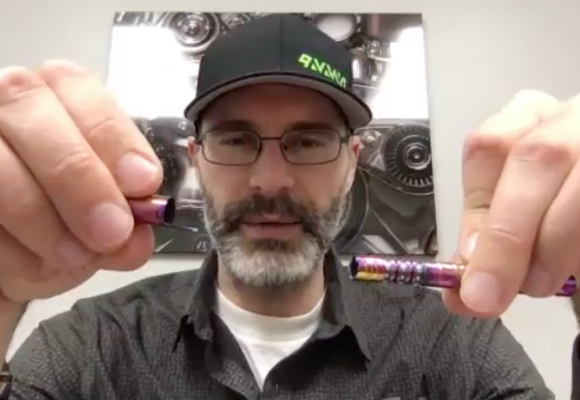On today’s episode we continue our season talking about companies who produce their own products.
Our guest is George Breiwa, founder of DynaVap, a company that produces a unique type of vaporizer, using Index multi-spindles and CNC Swiss lathes. George says that one of the keys to the company’s success is growing and nurturing a community of passionate customers.
Main Points
George describes DynaVap’s VapCap 2020 M vaporizer, which he prefers to refer to as a selective thermal extraction tool. To operate the VapCap M a user removes a temperature indicating cap and places a chosen substance (often dry herb) for consumption inside the extraction chamber. Then the user applies a portable heat source to the VapCap such as a lighter. George also showcases a battery powered induction heater that can be used with the VapCap. (3:10)
George talks about the differences between thermal extraction (using a vaporizer) and smoking. He says that when burning a smokable substance, portions of it are burned away rather than extracted, whereas with thermal extraction, the plant material is heated to a temperature where the active compounds evaporate and can be extracted, leaving everything else behind with minimal chemical changes a no incomplete combustion byproducts like tar, resin and carbon monoxide. (Fingers crossed that I summarized him correctly!) (5:05)
Noah asks George about the health ramifications of using DynaVap’s vaporizer. George says health and safety depends on the substance being extracted and if it is done in moderation. He suggests that using a VapCap is a healthier alternative to smoking. (6:40)
George describes how DynaVap’s products are machined. Tube stock is custom drawn at the mill in variable thicknesses to manufacture the various parts. Again, he shows the 2020 M VapCap, which does not require tools to assemble or disassemble its four parts. The 2020 M can be purchased in a variety of colors. George describes one color called rosium (see video), which he describes as pink, gold, and blue with a little bit of green. The color is produced through a process called PVD (physical vapor deposition), which he says is very commonly used when producing carbide cutting tools for CNC machines. He also describes another model the company sells called AzuriuM, which starts as blue but changes to several different colors when exposed to heat. (8:40)
George talks about the value proposition of DynaVap’s product, which uses an external heat source (like a lighter) rather than using a built-in battery like a typical vaporizer. He says the VapCap’s small size and portability are significant advantages. DynaVap’s products can fit in a person’s pocket and also are extremely durable because they don’t have sensitive electronic parts. He says a person can throw a VapCap on the ground or even drive over it with a car and it will hold up. He says he is confident DynaVap’s products will remain functional for 20 to 30 years if taken care of properly, and the only parts that may need to be replaced are the o-rings.(12:30)
George talks about how DynaVap makes its products. He says the tip is machined on an INDEX multi-spindle (MS22-8 with double NCU). (14:20)
George discusses the company’s approach to marketing its products. DynaVap focuses primarily on growing relationships with the customers it already has, giving them the tools and knowledge to talk about the product with others. He says the primary way people are introduced to the product is by personal interaction with others who already have it. (16:05)
George talks about the impact of building a community around a product. He says many of DynaVap’s customers learn about its products in online communities like Reddit. He says the ability to customize a product to suit a personal preference is highly appealing to the company’s customers. DynaVap designs its products so that creative people can customize certain components. It shares necessary dimensions with the public and even supplies certain materials for customers to make after-market accessories like interchangeable stems. Meanwhile, the high-precision parts are still made by DynaVap. DynaVap’s community of users post photos online of their homemade components. (18:50)
George explains that the starting cost of a DynaVap vaporizer is $75, while the top of the line models sell for $180-190. (21:05)
George says the most important factor in the company’s growth is its user community and “social proof.” This wasn’t something he initially realized, but he discovered that the more the company supported and engaged with customers, the more the customers shared their love of the products with others. (22:30)
George talks about how the DynaVap’s numerous online videos show how passionate he is about the company’s products. (23:55)
George says that getting customers to have a great experience with a product requires educating them. He says DynaVap devices are simple to use, but they do require users to learn how to operate them properly. He draws a comparison to a chef’s knife. Most people know how to use a knife, but how many people do so correctly? (25:00)
George states that while using DynaVap devices may seem to require more work than similar products, few customers seem concerned. The company’s user community also provides resources to overcome the initial learning curve. (26:35)
George says community enrichment of customers is a very important aspect of bringing a new product to market. He says if the customers don’t know who you are and you don’t know who your customers are, then you need to familiarize yourself and engage with them, or you will not be successful. (27:55)
George shares something he recently learned. He reports that traveling to Europe right now is not difficult. He just spent two weeks in Amsterdam on business. He traveled on commercial airlines in major airports and experienced no issues or concerns. His COVID-19 test was negative upon his return. (28:30)
Question: What online communities do you belong to?
Podcast: Play in new window | Download

